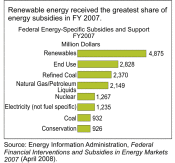03 May 2011 Where Have All the Energy Subsidies Gone?
As President Obama is all about ending subsidies to oil and gas companies, now would be a good time to review where most energy subsidies actually go. As the U.S. Energy Information Agency reports—and their graph below shows—the greatest share by far goes to renewable sources, such as wind, solar, and ethanol, not fossil fuels:

In terms of subsidies per unit of production—or the amount of government hand-outs per output of generation—renewables again receive far more. The wind industry gets a whopping $23 per megawatthour and solar gets $24, while coal gets a mere 44 cents and natural gas only 25 cents.
Subsidies for renewables also have been rising much faster than subsidies for any other sector of the energy industry. According to the EIA report, subsidies for renewables amounted to $1.4 billion on fiscal year 1999; by 2007, they had risen to $4.9 billion.
While these are EIA’s most up-to-date figures, we know subsidies for renewables since then have ballooned more than fivefold. Under Obama’s 2009 “stimulus” package, subsidies for renewables grew by at least $27 billion.
All this would be disturbing enough if it were not for the fact that Obama wants to use the revenues generated from eliminating oil and gas tax breaks “to invest in clean energy to reduce our dependence on foreign oil.”
How can the President even pretend to be serious about reducing our dependence on foreign oil when he has done everything in his power to bring domestic production to a crawl?
As Conn Carroll of the Heritage Foundation writes:
If Obama really wanted to reduce our dependence on foreign oil tomorrow he could end his Gulf of Mexico permitorium on offshore drilling.
And: While oil production in the Gulf is down more than 10% from April 2010 estimates, net crude oil imports are up 5%. At $83 dollars a barrel (the approximate average price of oil in the fourth quarter of 2010) that means Obama’s oil drilling permatorium increased American dependence on foreign oil by about $1.8 billion dollars in the fourth quarter of last year alone. The numbers only get worse as Obama’s permitorium further cuts into production. A Wood Mackenzie study predicts that for all of 2011 the permitorium will result in the loss this year of about 375,000 barrels of oil a day. More imported oil also means higher prices at the pumps. The EIA explains: “Retail gasoline prices tend to be higher the farther it is sold from the source of supply.” It costs more money to transport oil to your gas station from the Persian Gulf than from the Gulf of Mexico.
You can read the rest of his article here.



